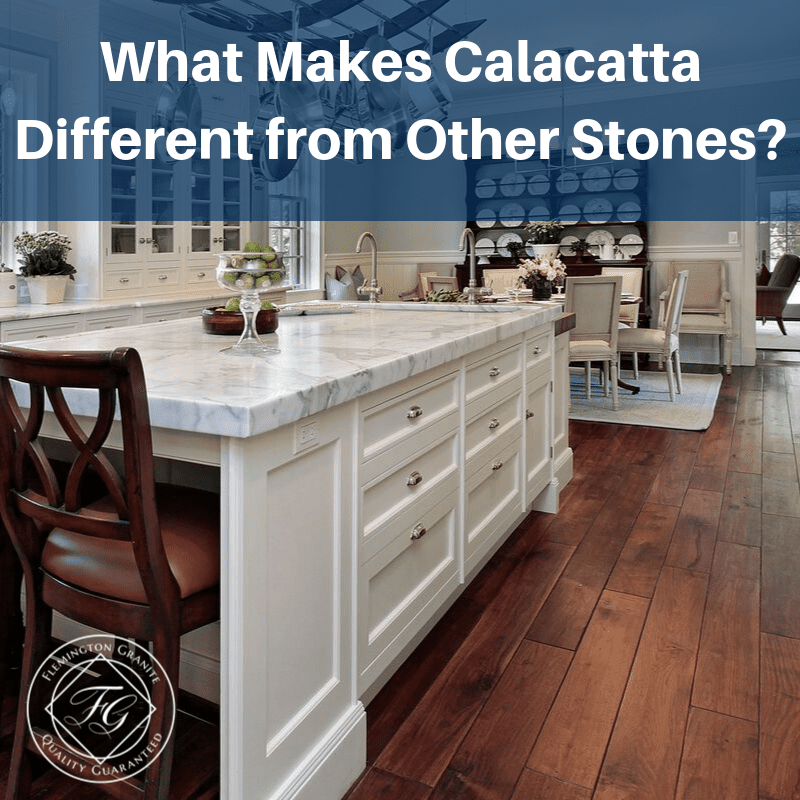
Marble countertops have grown in popularity over the past decade, creating rooms that make a statement. Marble sends a message of luxury and sophistication, but with so many options to choose from, you may be confused about what is the best option. You may even wonder why a marble countertop is a better choice than other types of natural stone. Understanding marble, especially calacatta marble, and knowing its advantages and disadvantages can help you choose the perfect stone for your kitchen.
About Calacata Marble
When you are looking at some types of countertops, like Corian, Silestone or Caesarstone, a sample gives you an idea of what your counter will look like once it is installed. It is much more difficult with marble, however, as every slab of marble is different. Nature creates a wide range of patterns and colors so veining in one slab of marble could look completely different in another slab, even if they are quarried at exactly the same time. Marble is quarried in many different parts of the world but the marble found in Carrara, a town in northern Italy, is one of the most readily available in the United States. Italian marble is found in three different types which include Calacatta, Carrara and Satuary.
Differences from Other Types of Marble
The first thing you need to do is to compare the three types of Italian marble to decide what will work best for you. Carrara marble is the most commonly found in this country. It has a gray background, or field as experts call it, with light gray veining. Often, the stone leans toward blue-gray and the veins are soft and feathery. Statuary, also quarried in Carrara, has a bright white background with little color variation. Veins are normally dark gray, giving the stone a distinct contrast between light and dark. Calacatta also has a bright white background but it offers a wider range of vein coloring. The veins in Calacatta are thick and dramatic, ranging in color from golds, browns, beige and dark gray.
Pricing Differences
Carrara is normally less expensive than the other types of marble quarried there. The average cost is $75 to $100 per square foot and it is plentiful. Calacatta and Statuary are much rarer and the supply is not as plentiful as Carrara so the cost is higher. There are slabs that cost as much as $250 per square foot. It is important to remember that costs vary by supplier as some are considered exclusive so they will charge more. They may also have more distinctive marbles to offer than the big box outlets who offer fewer options. Thickness also has an impact on how much marble costs. Countertops are cut to one or two centimeter thickness with one centimeter the most popular option as it is much less heavy to install.
Maintenance of Marble
The three stones require the same amount of maintenance as they have the same porosity. It is important to note that marble is not low-maintenance like quartz or granite. It is not acid-resistant, requiring the surface to be sealed when it is installed and then resealed periodically. This prevents it from being stained or etched by substances like red wine, tomato sauce, fruit juices or citrus fruits. Marble is also not as hard as granite which means it will chip if struck by a heavy skillet or other heavy object. It is also softer so it is prone to scratches or cracks if you don’t use a cutting board to protect het surface.
Choosing the Right Marble
As mentioned before, each slab of marble is different even if it has been quarried together. You will want to go to a showroom to compare colors and patterns on each slab to find those that fit what you need. If you have a small countertop, you may not need to worry about the differences in the slabs but large counter areas will require you to work with the experts to blend the slabs that work best together. It makes it difficult to shop around because showrooms often only have three or four slabs on premises. Most companies that work with natural stone will show you photographs of additional slabs to let you see what options you have.
What About Your Kitchen?
Because it is much less expensive, Carrara is probably the best option for the kitchen. It offers darker backgrounds and veining which will help you hide food stains, discolorations and marks from hot pans. The natural markings will be more obvious. However, if you have a larger budget and you’re a stickler for cleaning up any spills, Calacatta or Statuary may be the right option. Keep in mind that if you enjoy baking, marble is the perfect choice for a kitchen countertop. Pastry dough works well on the coolness of marble counters which is why many cooks now install marble insets in other types of countertops simply for pastry work.
Why Choose Marble?
Marble has been used as a building material for centuries and the fact that buildings with marble flooring, stairs, railings and more still look as stunning as they did when they were installed is a testament to the sophistication, beauty and durability of marble. Homes in Europe often have stone countertops due to their durability and cooking benefits. Even though marble can stain easily, many people like the patina that develops over time and find the slight stains to make their counters unique from other marble counters.
If you are considering marble countertops, it is important to understand the difference between marble and other types of stones, including quartz, granite, soapstone and more. We can help you choose the right natural stone for your family’s needs. Contact us today by giving us a call or filling out the easy form online to speak to a customer service representative who can guide you through the process and help you select the perfect natural stone.
